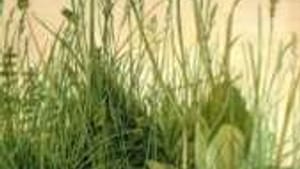Stay in the Loop
BSR publishes on a weekly schedule, with an email newsletter every Wednesday and Thursday morning. There’s no paywall, and subscribing is always free.
In weeds we trust, or: What made Albrecht Dürer happy?
Albrecht Dürer at National Gallery in D.C. (1st review)

"Love and delight are better teachers of the art of painting than compulsion is." So said Albrecht Dürer (1471-1528), long considered the greatest German artist of the Northern Renaissance.
Jackson Pollock, the abstract expressionist splash painter, or the much celebrated and mercurially inspired Pablo Picasso might disagree, if either had the opportunity of a cross-century chat with the Old Master. But it's clear from the National Gallery's new exhibition of 91 master drawings, watercolors and prints, plus 27 engravings and woodcuts, that Dürer truly did believe that God is in the details, lovingly and carefully expressed.
Dürer's particularly refined precision in craftsmanship is evident in this marvelous collection, on loan from the Albertina Museum in Vienna. It includes such well-known images as The Great Piece of Turf, perhaps the earliest depiction of plant life; The Praying Hands, a study for an altarpiece completed with Mathias Grunewald and perhaps the most famous drawing of all time; and the silverpoint Self Portrait at Thirteen, evidence indeed of a young man's prodigy and destiny.
If only we could add a few more painted self-portraits of the heartthrob-handsome Dürer, as well as his famous bunny painting (officially called Hare), we could easily consider ourselves in Dürer heaven.
How to paint turf
But these 118 works are heaven enough and opportunity enough for a viewer to flex one's observational skills of all those details. Dürer's is no dry and pedantic rendering. The best of his work exudes a lightness and fluidity to the line, and a certain humor too.
Take A Great Piece of Turf, for example. This watercolor features a group of wild plants rooted together, seemingly at random, in a hunk of turf. Botanical experts who have examined this painting claim to have discerned dandelion, cock's foot, creeping bent, smooth meadow grass, daisy, germander, speedwell, greater plantain, hounds tongue, and yarrow. Might Dürer have actually found a piece of turf with these particular plants living side by side and then painted it on the spot as he saw it?
We know that Renaissance artists didn't work this way. Durer may have made sketches outdoors and then collected plants over a period of time, positioning them side by side in his study, possibly in unlikely pairings, to paint them. But in the studio those marvelous grasses wouldn't rhythmically "move" or those roots "reach" in the way that Durer has "captured" them in the painting. The resulting work is thus an amalgam of both observation and imagination rather than a scientific on site recording of indigenous plant life. This work has a certain au plein air liveliness to it that studio-studied botanical art doesn't even seek to describe.
Painted tonal gradations of umber and mint green with daubs of aquamarine and amber serve to reinforce this liveliness effect. The backdrop is rendered with subtle watercolor washes, light and color merged.
Exuberant garden
This exhibition also includes The Virgin and Child Among a Multitude of Animals, an ink and watercolor nativity scene with a difference: Mary and Jesus are seated in a garden, a paradise of exquisitely detailed plant and animal life. The baby leans to pick a flower while a stag beetle teases the Virgin's sleepy dog. A butterfly is alighting upon the dog's back. Ducks, crabs, lions, parrots, frogs, moths, dragonflies cavort and cohabit harmoniously.
The fox— a symbol of evil— is leashed, so all is joyous with this world. This is Dürer's exuberant vision of the promise of Christ's birth on earth.
Two engravings— Knight, Death and Devil and Melancholia 1— reveal that Dürer was familiar with deep suffering too. Although he remained a Roman Catholic throughout his life, these particular works confess a wavering faith.
Worshipping weeds
Dürer prodigiously produced religious images, including portraits of the Protestant cleric Martin Luther. Yet these were not the wellspring of his most generous and exalted expression. Viewing the range of Dürer's work, we see his delight and most devoted attention in the rendering of the natural world.
Nature may well be compulsively "red in tooth and claw," as the poet Alfred Lord Tennyson suggested. But Dürer's expression of everyday weeds, turf, crabs and beetles are the highest form of art. This marvelous National Gallery exhibition readily demonstrates that Dürer could walk his own talk. Indeed, its implied message is: You've got to love something in order to best express it.♦
To read another review by Robert Zaller, click here.
Jackson Pollock, the abstract expressionist splash painter, or the much celebrated and mercurially inspired Pablo Picasso might disagree, if either had the opportunity of a cross-century chat with the Old Master. But it's clear from the National Gallery's new exhibition of 91 master drawings, watercolors and prints, plus 27 engravings and woodcuts, that Dürer truly did believe that God is in the details, lovingly and carefully expressed.
Dürer's particularly refined precision in craftsmanship is evident in this marvelous collection, on loan from the Albertina Museum in Vienna. It includes such well-known images as The Great Piece of Turf, perhaps the earliest depiction of plant life; The Praying Hands, a study for an altarpiece completed with Mathias Grunewald and perhaps the most famous drawing of all time; and the silverpoint Self Portrait at Thirteen, evidence indeed of a young man's prodigy and destiny.
If only we could add a few more painted self-portraits of the heartthrob-handsome Dürer, as well as his famous bunny painting (officially called Hare), we could easily consider ourselves in Dürer heaven.
How to paint turf
But these 118 works are heaven enough and opportunity enough for a viewer to flex one's observational skills of all those details. Dürer's is no dry and pedantic rendering. The best of his work exudes a lightness and fluidity to the line, and a certain humor too.
Take A Great Piece of Turf, for example. This watercolor features a group of wild plants rooted together, seemingly at random, in a hunk of turf. Botanical experts who have examined this painting claim to have discerned dandelion, cock's foot, creeping bent, smooth meadow grass, daisy, germander, speedwell, greater plantain, hounds tongue, and yarrow. Might Dürer have actually found a piece of turf with these particular plants living side by side and then painted it on the spot as he saw it?
We know that Renaissance artists didn't work this way. Durer may have made sketches outdoors and then collected plants over a period of time, positioning them side by side in his study, possibly in unlikely pairings, to paint them. But in the studio those marvelous grasses wouldn't rhythmically "move" or those roots "reach" in the way that Durer has "captured" them in the painting. The resulting work is thus an amalgam of both observation and imagination rather than a scientific on site recording of indigenous plant life. This work has a certain au plein air liveliness to it that studio-studied botanical art doesn't even seek to describe.
Painted tonal gradations of umber and mint green with daubs of aquamarine and amber serve to reinforce this liveliness effect. The backdrop is rendered with subtle watercolor washes, light and color merged.
Exuberant garden
This exhibition also includes The Virgin and Child Among a Multitude of Animals, an ink and watercolor nativity scene with a difference: Mary and Jesus are seated in a garden, a paradise of exquisitely detailed plant and animal life. The baby leans to pick a flower while a stag beetle teases the Virgin's sleepy dog. A butterfly is alighting upon the dog's back. Ducks, crabs, lions, parrots, frogs, moths, dragonflies cavort and cohabit harmoniously.
The fox— a symbol of evil— is leashed, so all is joyous with this world. This is Dürer's exuberant vision of the promise of Christ's birth on earth.
Two engravings— Knight, Death and Devil and Melancholia 1— reveal that Dürer was familiar with deep suffering too. Although he remained a Roman Catholic throughout his life, these particular works confess a wavering faith.
Worshipping weeds
Dürer prodigiously produced religious images, including portraits of the Protestant cleric Martin Luther. Yet these were not the wellspring of his most generous and exalted expression. Viewing the range of Dürer's work, we see his delight and most devoted attention in the rendering of the natural world.
Nature may well be compulsively "red in tooth and claw," as the poet Alfred Lord Tennyson suggested. But Dürer's expression of everyday weeds, turf, crabs and beetles are the highest form of art. This marvelous National Gallery exhibition readily demonstrates that Dürer could walk his own talk. Indeed, its implied message is: You've got to love something in order to best express it.♦
To read another review by Robert Zaller, click here.
What, When, Where
“Albrecht Dürer: Master Drawings, Watercolors, and Prints from the Albertina.†Through June 9, 2013 at National Gallery of Art, East Building Mezzanine, Fourth St. and Constitution Avenue, Washington D.C. (202) 737-4215 or www.nga.gov.
Sign up for our newsletter
All of the week's new articles, all in one place. Sign up for the free weekly BSR newsletters, and don't miss a conversation.

 Victoria Skelly
Victoria Skelly